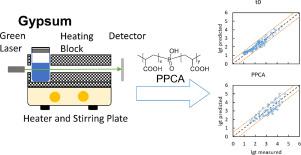Water Research ( IF 11.4 ) Pub Date : 2022-09-24 , DOI: 10.1016/j.watres.2022.119166 Zhaoyi Dai 1 , Yue Zhao 2 , Samridhdi Paudyal 3 , Xin Wang 3 , Chong Dai 3 , Saebom Ko 3 , Wei Li 3 , Amy T Kan 3 , Mason B Tomson 3

|
Water desalination using membrane technology is one of the main technologies to resolve water pollution and scarcity issues. In the membrane treatment process, mineral scale deposition and fouling is a severe challenge that can lead to filtration efficiency decrease, permeate quality compromise, and even membrane damage. Multiple methods have been developed to resolve this problem, such as scale inhibitor addition, product recovery ratio adjustment, periodic membrane surface flushing. The performance of these methods largely depends on the ability to accurately predict the kinetics of mineral scale deposition and fouling with or without inhibitors. Gypsum is one of the most common and troublesome inorganic mineral scales in membrane systems, however, no mechanistic model is available to accurately predict the induction time of gypsum crystallization and inhibition. In this study, a new gypsum crystallization and inhibition model based on the classical nucleation theory and a Langmuir type adsorption isotherm has been developed. Through this model, it is believed that gypsum nucleation may gradually transit from homogeneous to heterogeneous nucleation when the gypsum saturation index (SI) decreases. Such transition is represented by a gradual decrease of surface tension at smaller SI values. This model assumes that the adsorption of inhibitors onto the gypsum nucleus can increase the nucleus superficial surface tension and prolong the induction time. Using the new model, this study accurately predicted the gypsum crystallization induction times with or without nine commonly used scale inhibitors over wide ranges of temperature (25–90 °C), SI (0.04–0.96), and background NaCl concentration (0–6 mol/L). The fitted affinity constants between scale inhibitors and gypsum show a good correlation with those between the same inhibitors and barite, indicating a similar inhibition mechanism via adsorption. Furthermore, by incorporating this model with the two-phase mineral deposition model our group developed previously, this study accurately predicts the gypsum deposition time on the membrane material surfaces reported in the literature. We believe that the model developed in this study can not only accurately predict the gypsum crystallization induction time with or without scale inhibitors, elucidate the gypsum crystallization and inhibition mechanisms, but also optimize the mineral scale control in the membrane filtration system.
中文翻译:

石膏水垢形成和抑制动力学对膜系统的影响
利用膜技术进行海水淡化是解决水污染和水资源短缺问题的主要技术之一。在膜处理过程中,矿物水垢沉积和结垢是一项严峻的挑战,会导致过滤效率下降、渗透质量下降,甚至膜损坏。已经开发了多种方法来解决这个问题,例如添加阻垢剂、调节产品回收率、定期膜表面冲洗。这些方法的性能在很大程度上取决于准确预测矿物水垢沉积和有或没有抑制剂的结垢动力学的能力。石膏是膜系统中最常见和最麻烦的无机矿物垢之一,然而,没有可用的机理模型来准确预测石膏结晶和抑制的诱导时间。在这项研究中,基于经典成核理论和朗缪尔型吸附等温线,开发了一种新的石膏结晶和抑制模型。通过该模型,认为当石膏饱和指数(SI ) 减小。这种转变表现为在较小的SI值下表面张力的逐渐降低。该模型假设抑制剂吸附到石膏核上可以增加核表面张力并延长诱导时间。使用新模型,本研究准确预测了在宽温度范围(25–90 °C)内使用或不使用九种常用阻垢剂的石膏结晶诱导时间,SI(0.04–0.96) 和背景 NaCl 浓度 (0–6 mol/L)。阻垢剂和石膏之间的拟合亲和常数与相同阻垢剂和重晶石之间的亲和常数显示出良好的相关性,表明通过吸附具有相似的抑制机制。此外,通过将该模型与我们小组先前开发的两相矿物沉积模型相结合,该研究准确地预测了文献中报道的膜材料表面的石膏沉积时间。我们认为,本研究开发的模型不仅可以准确预测有或没有阻垢剂的石膏结晶诱导时间,阐明石膏结晶和抑制机理,还可以优化膜过滤系统中的矿物结垢控制。










































 京公网安备 11010802027423号
京公网安备 11010802027423号